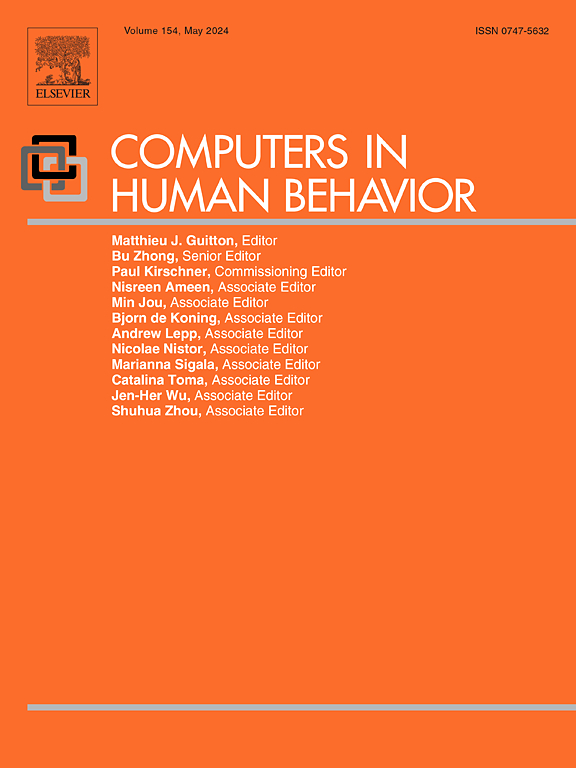青少年数字能力方面的社会、性别和移民相关差异的发展
IF 8.9
1区 心理学
Q1 PSYCHOLOGY, EXPERIMENTAL
引用次数: 0
摘要
青少年有效使用数字技术的能力分布不均。社会经济背景较低的青年、女孩和移民往往表现出较低的数字能力,这可能导致长期的教育和职业劣势。要设计促进数字公平的教育战略,就必须了解这些不平等是何时以及为谁而出现的。这项纵向研究考察了青少年数字能力的社会、性别和移民相关差异的发展。使用德国国家教育小组研究(N = 4872)的数据,我们检查了在12至18岁之间通过标准化成就测试进行三次评估的数字能力。潜在增长曲线分析揭示了不同的发展模式:社会经济差距最初很大(Cohen’s d = - 0.22),但随着时间的推移而缩小(Cohen’s d = - 0.16);性别差异在开始时很小(Cohen’s d = 0.07),但在青春期扩大(Cohen’s d = 0.18);而移民之间的差距在青春期早期就已经很大了(Cohen’s d = - 0.18),并在以后保持稳定。对数学和阅读能力的比较分析突出了数字不平等与传统教育不平等之间的部分相似之处。总体而言,研究结果表明,在整个青少年时期,与数字能力相关的社会、性别和移民差异持续存在。由于这些差距在青春期后期仍然相当大,目前的教育制度似乎没有充分解决这些问题。为了减少数字不平等,教育干预可能需要在青春期之前就开始,并针对更年幼的儿童,以防止差距变得根深蒂固。本文章由计算机程序翻译,如有差异,请以英文原文为准。
The development of social, gender, and migration-related disparities in digital competencies during adolescence
The ability to use digital technologies effectively is unevenly distributed among adolescents. Youths from lower socioeconomic backgrounds, girls, and migrants frequently exhibit lower digital competencies, which can contribute to long-term educational and occupational disadvantages. To design educational strategies that promote digital equity, it is essential to understand when and for whom these inequalities emerge. This longitudinal study examined the development of social, gender, and migration-related disparities in digital competencies during adolescence. Using data from the German National Educational Panel Study (N = 4872), we examined digital competencies that were assessed three times between ages 12 and 18 with standardized achievement tests. Latent growth curve analyses revealed distinct developmental patterns: socioeconomic disparities were initially large (Cohen's d = −0.22) but decreased over time (Cohen's d = −0.16); gender differences favoring boys were small at first (Cohen's d = 0.07) but widened during adolescence (Cohen's d = 0.18); and the migrant gap was already substantial in early adolescence (Cohen's d = −0.18) and remained stable later on. Comparative analyses for math and reading literacy highlighted partial parallels between digital inequalities and traditional educational inequalities. Overall, the results indicated persistent social, gender, and migration-related disparities in digital competencies throughout adolescence. Because these gaps remained considerable in later adolescence, they appear insufficiently addressed by the current educational system. To reduce digital inequalities, educational interventions may need to begin even before adolescence and target younger children in order to prevent disparities from becoming firmly established.
求助全文
通过发布文献求助,成功后即可免费获取论文全文。
去求助
来源期刊

Computers in Human Behavior
Multiple-
CiteScore
19.10
自引率
4.00%
发文量
381
审稿时长
40 days
期刊介绍:
Computers in Human Behavior is a scholarly journal that explores the psychological aspects of computer use. It covers original theoretical works, research reports, literature reviews, and software and book reviews. The journal examines both the use of computers in psychology, psychiatry, and related fields, and the psychological impact of computer use on individuals, groups, and society. Articles discuss topics such as professional practice, training, research, human development, learning, cognition, personality, and social interactions. It focuses on human interactions with computers, considering the computer as a medium through which human behaviors are shaped and expressed. Professionals interested in the psychological aspects of computer use will find this journal valuable, even with limited knowledge of computers.
 求助内容:
求助内容: 应助结果提醒方式:
应助结果提醒方式:


